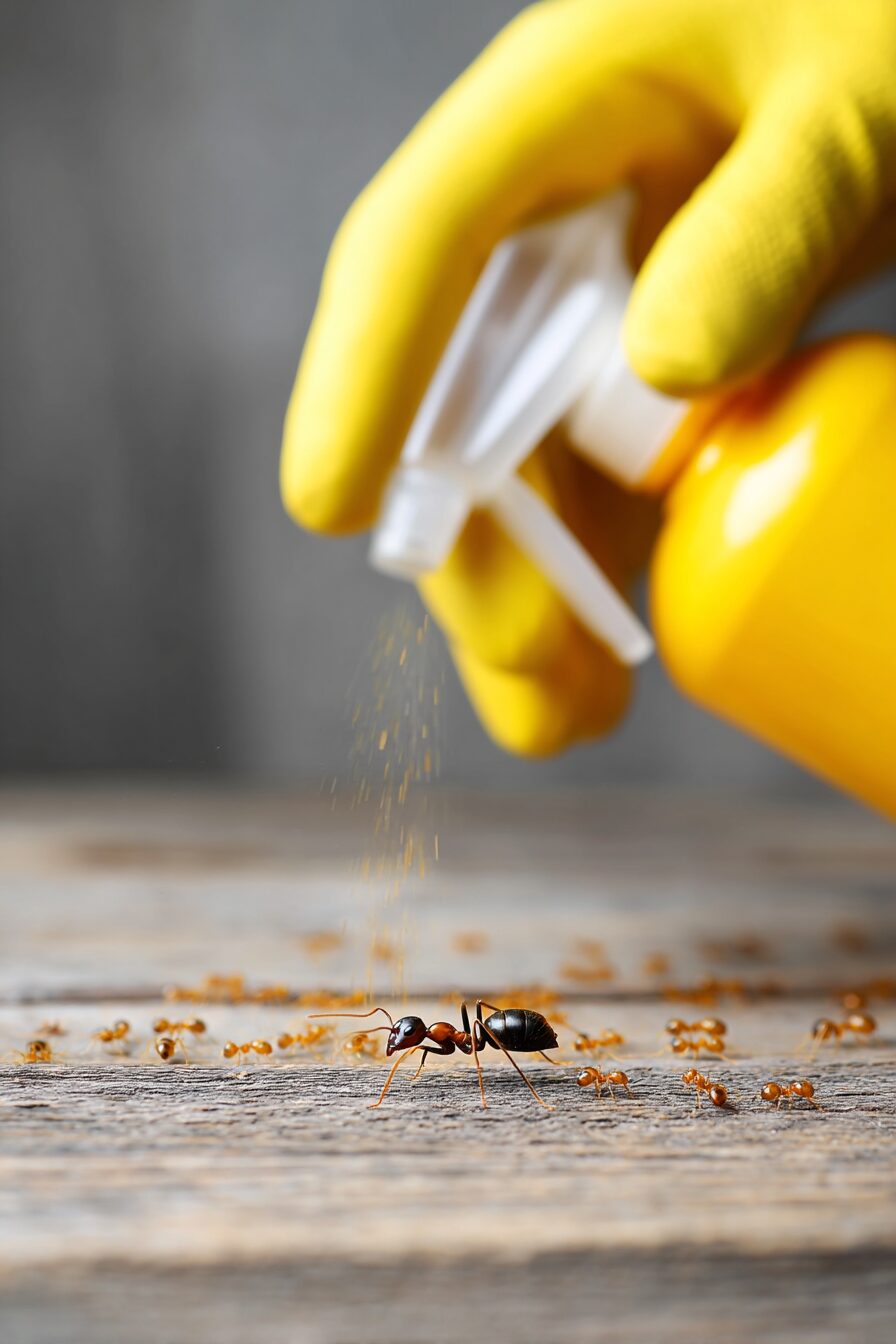Finding a trail of ants marching across your kitchen counter is enough to make anyone’s skin crawl.
These tiny invaders seem to appear out of nowhere, turning your peaceful home into their personal playground.
But don’t worry!
With the right strategies, you can send these unwelcome guests packing for good.
Here are proven methods to kick those ants to the curb and reclaim your space.
Identify and Seal Entry Points

Ants don’t need a welcome mat to enter your home – they’ll squeeze through the tiniest cracks and gaps without an invitation.
A thorough inspection of your home’s foundation, walls, windows, and doors can reveal where these persistent pests are getting in.
Grab a flashlight and check around pipes, utility lines, door frames, window sills, and foundation cracks, as these are common ant highways into your home.
Once you’ve identified potential entry points, it’s time to seal them up with caulk, weather stripping, or other appropriate materials.
Silicone caulk works wonders for sealing cracks in your foundation or gaps around windows and doors, creating a barrier that ants can’t penetrate.
Don’t forget to check your screens for holes or tears, as ants can easily use these as doorways into your living space.
For larger gaps, expanding foam insulation can be an effective solution that not only keeps ants out but also improves your home’s energy efficiency.
Pay special attention to areas where moisture might be attracting ants, such as leaky pipes or areas with water damage.
Remember that different ant species have different preferences for entry points – carpenter ants, for instance, are drawn to damp, rotting wood.
A quarterly inspection of your home’s exterior can help you stay ahead of potential ant invasions by addressing new entry points as they develop.
Window sills and frames deserve extra scrutiny, as they frequently develop small cracks and gaps over time.
Don’t overlook your home’s roof and eaves, as some ant species may enter from above, especially if tree branches touch your roof.
In older homes, check baseboards and crown molding, as these can separate from walls over time and create tiny highways for ants.
Utility penetrations – where electrical lines, gas pipes, or water lines enter your home – are often overlooked entry points that need sealing.
Keeping vegetation trimmed back from your home’s exterior can also reduce the number of ants that make it to your walls in the first place.
The best part about sealing entry points is that this method doesn’t just work for ants – it also keeps out other unwanted pests like cockroaches and spiders.
This method may take some time and effort upfront, but it provides long-term protection against recurring ant problems.
Combine this approach with other methods mentioned in this article for the most effective ant defense system.
TRENDING NOW
Simple Tips To Help Seniors Declutter Their RoomsVinegar: Your Secret Weapon Against Ant Trails

One of the most effective and budget-friendly ways to combat ants is sitting right in your pantry – plain old vinegar.
The strong scent of vinegar disrupts ants’ pheromone trails, essentially erasing the chemical highways they use to communicate and navigate.
A simple solution of equal parts white vinegar and water in a spray bottle creates a powerful ant deterrent that’s safe to use around children and pets.
Spray this solution directly on ant trails, entry points, countertops, and anywhere else you’ve spotted the tiny invaders.
The acidic nature of vinegar not only eliminates their scent trails but also acts as a natural repellent that ants absolutely hate.
For extra strength, try using undiluted white vinegar in areas where ants are particularly persistent.
Apple cider vinegar works too, but the strong smell might linger longer than white vinegar, so choose based on your personal preference.
Regular application is key – spray problematic areas daily until you notice a significant decrease in ant activity.
Don’t worry about the vinegar smell; it dissipates quickly once dry, leaving your surfaces clean and ant-free.
For kitchen counters and food preparation areas, vinegar serves double duty by disinfecting surfaces while deterring ants.
Pay special attention to spray along baseboards, window sills, door frames, and other common ant highways.
The beauty of the vinegar method is that you’re not just killing individual ants but preventing entire colonies from finding their way back to food sources in your home.
If you’re dealing with an ant infestation around pet food areas, vinegar is particularly useful since it’s non-toxic to your furry friends.
For outdoor use, consider spraying vinegar around the perimeter of your home, creating a barrier that many ants won’t cross.
Some homeowners report success with adding a few drops of essential oils like peppermint or tea tree to their vinegar solution for enhanced repellent properties.
Remember to reapply after rain or watering if you’re treating outdoor areas, as the solution washes away easily.
The vinegar trick works particularly well when combined with proper cleaning habits – make sure to wipe up food spills promptly and keep surfaces clean.
One smart strategy is to use the vinegar spray after removing all visible ants, ensuring that reinforcements can’t follow the chemical trail back to the food source.
While vinegar won’t kill ants directly, it’s extremely effective at disrupting their behavior and making your home much less inviting to them.
As an added bonus, regular vinegar cleaning helps eliminate other household odors that might be attracting ants in the first place.
Design Your Dream Room in Minutes!
🏡 Start Creating FREE →Diatomaceous Earth: The Natural Ant Killer

Diatomaceous Earth (DE) might sound like something from a science fiction novel, but it’s actually a powerful, natural ant killer that’s been used for decades.
This fine powder consists of fossilized remains of tiny aquatic organisms called diatoms, whose skeletons are made of silica.
The magic of DE lies in its microscopic sharp edges, which cut through ants’ exoskeletons and cause them to dehydrate and die.
Despite its lethal effect on insects, food-grade diatomaceous earth is safe to use around humans and pets, making it an excellent choice for households with children or animals.
Application is straightforward – simply sprinkle a thin layer of DE in areas where you’ve seen ant activity, including entry points, along baseboards, and under appliances.
For best results, apply the powder when surfaces are dry, as moisture reduces its effectiveness.
The great thing about DE is that it continues working as long as it remains dry, providing long-lasting protection against ant invasions.
Unlike chemical pesticides, ants cannot develop resistance to diatomaceous earth, as its action is physical rather than chemical.
When applying DE, use a duster, small spoon, or even a salt shaker to create a fine, even layer – you don’t need thick piles for it to be effective.
Focus on cracks, crevices, and hidden spaces where ants travel, as these are the areas where the powder will have the most impact.
For outdoor use, create a protective barrier around your home’s foundation, but remember to reapply after rain or heavy dew.
One impressive feature of diatomaceous earth is that ants cannot detect it, so they’ll walk right through it, unwittingly carrying it back to their colony on their bodies.
This means DE can sometimes eliminate entire ant colonies, not just the scouts you see in your home.
When purchasing diatomaceous earth, always choose food-grade DE rather than the type used for pool filters, which has been treated with chemicals and is not safe for home use.
Some users mix DE with a small amount of sugar to attract ants more quickly to the treated areas, speeding up the elimination process.
Be patient when using diatomaceous earth – it works more slowly than chemical pesticides but provides more sustainable, safer results.
For persistent ant problems, consider creating permanent DE barriers in wall voids, behind electrical outlets, or under sink cabinets where ants commonly travel.
While DE is considered safe, it’s best to wear a dust mask when applying large amounts to avoid inhaling the fine particles, which can irritate lungs.
The powder is virtually undetectable once settled, making it a discreet solution for visible areas of your home.
As an added benefit, diatomaceous earth also works against other crawling insects like cockroaches, silverfish, and even bed bugs, giving you broader pest protection.
Boric Acid Baits: Deadly but Safe for Your Family
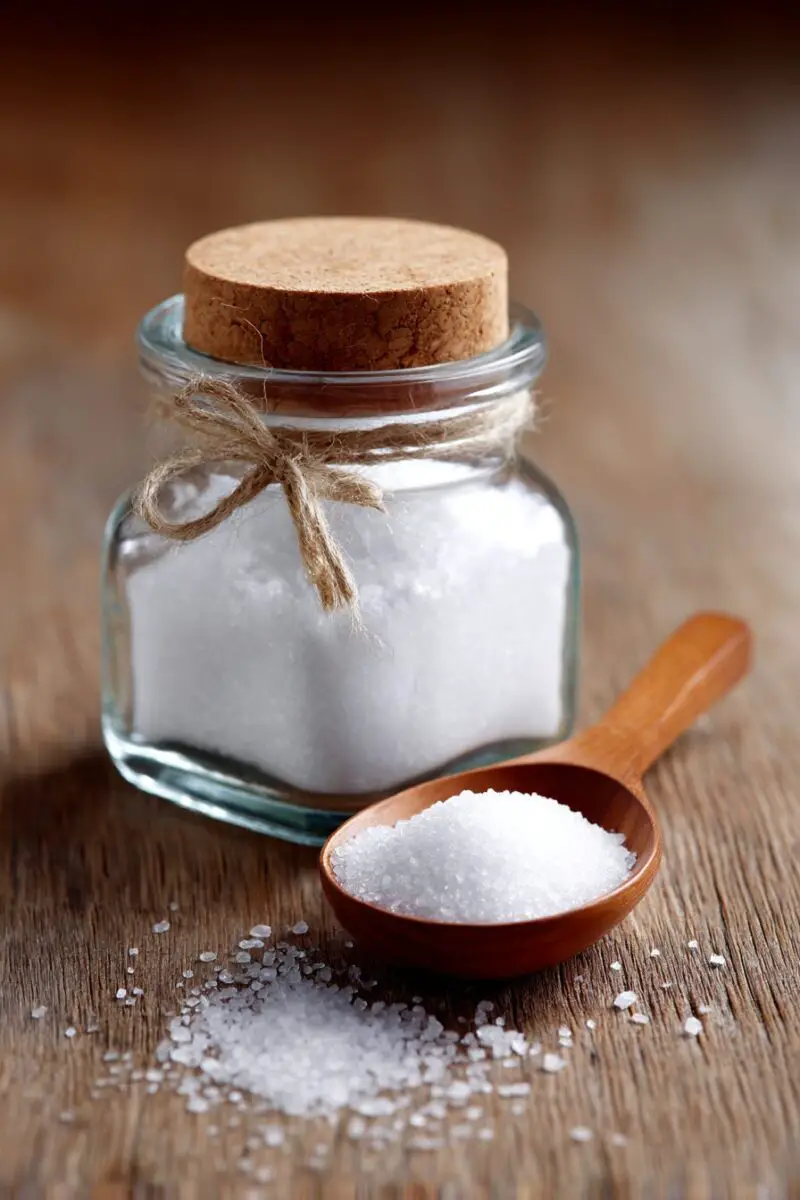
Boric acid has earned its reputation as one of the most reliable ant killers, working with deadly efficiency while remaining relatively safe for humans when used properly.
The beauty of boric acid lies in its delayed toxic effect – ants consume it, return to their colony, and share it with others before dying, helping eliminate the entire nest.
Creating effective boric acid baits at home is simple and requires just a few common household ingredients.
Mix one part boric acid (available at most hardware stores) with ten parts sweet food that ants find irresistible – honey, maple syrup, or sugar water work wonderfully.
The sweet bait attracts the ants while the boric acid acts as a slow-acting poison that disrupts their digestive systems and eventually kills them.
For protein-loving ants, mixing boric acid with peanut butter or canned tuna can be particularly effective during certain times of year when colonies need protein.
Place your homemade bait in small containers like bottle caps or on pieces of cardboard in areas with high ant activity, but away from children and pets.
Patience is key with this method – it may take several days to see results as the poison works its way through the colony.
The slow-acting nature of boric acid is actually its greatest strength, as it allows worker ants time to carry the poison back to the nest and feed it to the queen and larvae.
For maximum effectiveness, place multiple bait stations around your home, focusing on ant trails and entry points.
Replace the bait every few days to ensure it remains moist and attractive to ants.
While boric acid is less toxic than many commercial pesticides, it should still be handled with care – always wear gloves when preparing baits and wash your hands thoroughly afterward.
Keep boric acid baits out of reach of children and pets by placing them in areas that are inaccessible or by using commercially available bait stations.
One clever application method is to inject boric acid mixture into small straws, seal the ends, and place these baited straws in strategic locations where ants can access them but children and pets cannot.
If you’re concerned about using boric acid indoors, focus your baiting efforts outside near ant nests or along exterior walls where ants enter your home.
The concentration of boric acid is crucial – too much, and ants will die before returning to the nest; too little, and it won’t be effective.
For persistent or large infestations, consider combining boric acid baits with other methods like diatomaceous earth or vinegar sprays for a multi-pronged approach.
Commercial boric acid ant baits are also available if you prefer not to mix your own, offering the same benefits in a ready-to-use package.
Remember that different ant species may respond better to different bait formulations – if ants ignore your sweet bait, try a protein-based one instead.
The key advantage of boric acid over instant-kill sprays is that it addresses the root of your ant problem by eliminating the colony, not just the visible workers in your home.
Essential Oils That Ants Absolutely Hate

When it comes to natural ant repellents, essential oils stand out as powerful aromatic deterrents that can send ants scurrying in the opposite direction.
The strong scents of certain essential oils disrupt ants’ ability to follow pheromone trails and communicate with each other, effectively creating confusion in their ranks.
Peppermint oil tops the list of ant-repelling essential oils, with its intense menthol scent that ants find completely overwhelming.
Creating a simple peppermint spray by adding 15-20 drops of peppermint oil to a spray bottle filled with water gives you an effective ant deterrent that also leaves your home smelling fresh.
Tea tree oil, with its powerful medicinal scent, serves as another excellent option that most ant species actively avoid.
Lemon eucalyptus oil combines citrus and medicinal notes that create an invisible barrier ants rarely cross, making it perfect for doorways and windowsills.
Cinnamon oil not only repels ants but can actually kill them on contact, though it should be used carefully as it may damage certain surfaces.
For a comprehensive approach, consider creating a blend of multiple essential oils – combining peppermint, tea tree, and citrus oils creates a particularly potent ant deterrent.
When applying essential oils, focus on entry points, ant trails, and areas where food is prepared or stored, as these are prime targets for ant activity.
Reapplication is necessary every few days, as the scent diminishes over time, especially in high-traffic areas or outdoor spaces.
Cotton balls soaked in essential oils and placed in cabinets, behind appliances, or near entry points provide a slow-release repellent effect that can last for days.
For a more permanent solution, add 10-15 drops of essential oil to a quarter cup of water and a quarter cup of vodka (which helps the oil and water mix), then spray along baseboards and entry points.
If you have wood surfaces that ants seem to favor, try rubbing a few drops of cedarwood or sandalwood oil directly on the wood – these oils are natural preservatives that won’t damage wood while deterring ants.
Citrus oils extracted from lemon, orange, or grapefruit peels create a fresh-smelling barrier that most ant species refuse to cross.
The beauty of using essential oils lies in their dual purpose – they repel ants while simultaneously making your home smell wonderful.
For outdoor use, consider soaking rope or twine in essential oils and laying it around garden beds or along the foundation of your home to create a scented barrier.
Remember that while essential oils are natural, they can be potent – keep them away from the eyes and mouth, and dilute properly before use.
Some essential oils, particularly tea tree and peppermint, can be irritating to pets, especially cats, so use with caution if you have animal companions.
For a child-safe approach, lavender oil offers a gentler alternative that still effectively deters ants while being one of the safest essential oils for use around young children.
The aromatherapy benefits of these oils – such as the stress-relieving properties of lavender or the energizing effects of peppermint – provide an added bonus to your ant-fighting efforts.
Coffee Grounds: A Surprising Ant Repellent

Your morning coffee routine might be providing you with more than just a caffeine boost – those used coffee grounds can be repurposed as an effective ant deterrent.
The strong smell of coffee grounds masks ants’ scent trails and disorients them, making it difficult for them to navigate toward food sources in your home.
Many ant species have a natural aversion to coffee grounds, possibly due to the compounds caffeine and diterpenes found in coffee that can be toxic to certain insects.
Implementing this method couldn’t be simpler – just collect your used coffee grounds and allow them to dry completely before use.
Sprinkle the dried grounds along windowsills, near door thresholds, around pet food dishes, and anywhere else you’ve noticed ant activity.
For garden areas suffering from ant invasions, coffee grounds serve double duty – repelling ants while adding valuable nutrients to your soil as they decompose.
The slightly acidic nature of coffee grounds makes them particularly effective against alkaline-loving ant species, disrupting the pH balance they prefer.
Unlike many commercial ant repellents, coffee grounds are completely non-toxic to humans and pets, making them ideal for households with children or animals.
Creating a coffee ground barrier around your home’s foundation can serve as an excellent first line of defense, especially during spring and summer when ant activity peaks.
For potted plants that seem to attract ants, mix coffee grounds into the top layer of soil or create a protective circle of grounds around the base of the plant.
The absorbent quality of coffee grounds helps them work even in slightly damp conditions, though their effectiveness diminishes if they become completely saturated.
Some homeowners report success with mixing coffee grounds with orange peels for an extra-potent natural ant repellent that combines two scents ants typically avoid.
For indoor use, small sachets of dried coffee grounds placed in cabinets, under sinks, or near trash cans can help keep these ant-attracting areas pest-free.
One ingenious application involves creating a paste of coffee grounds and water to fill small cracks or holes where ants might be entering – as the mixture dries, it forms a temporary seal with ant-repelling properties.
The coarse texture of coffee grounds may also serve as a physical deterrent, as some ants dislike crawling over rough surfaces.
Remember to replace outdoor coffee ground barriers after heavy rain, as wet grounds lose their effectiveness and can develop mold if left too long.
For those who don’t brew coffee at home, many coffee shops give away used grounds for free to gardeners – just ask at your local café.
Some ant species may be more deterred by coffee grounds than others, so this method works best as part of a comprehensive approach rather than a standalone solution.
One particularly effective strategy involves creating a coffee ground barrier around the perimeter of picnic areas or outdoor dining spaces to keep ants away from food.
The environmental benefits of repurposing coffee grounds instead of discarding them add an eco-friendly dimension to this natural ant control method.
Commercial Ant Baits: When to Use Them and How
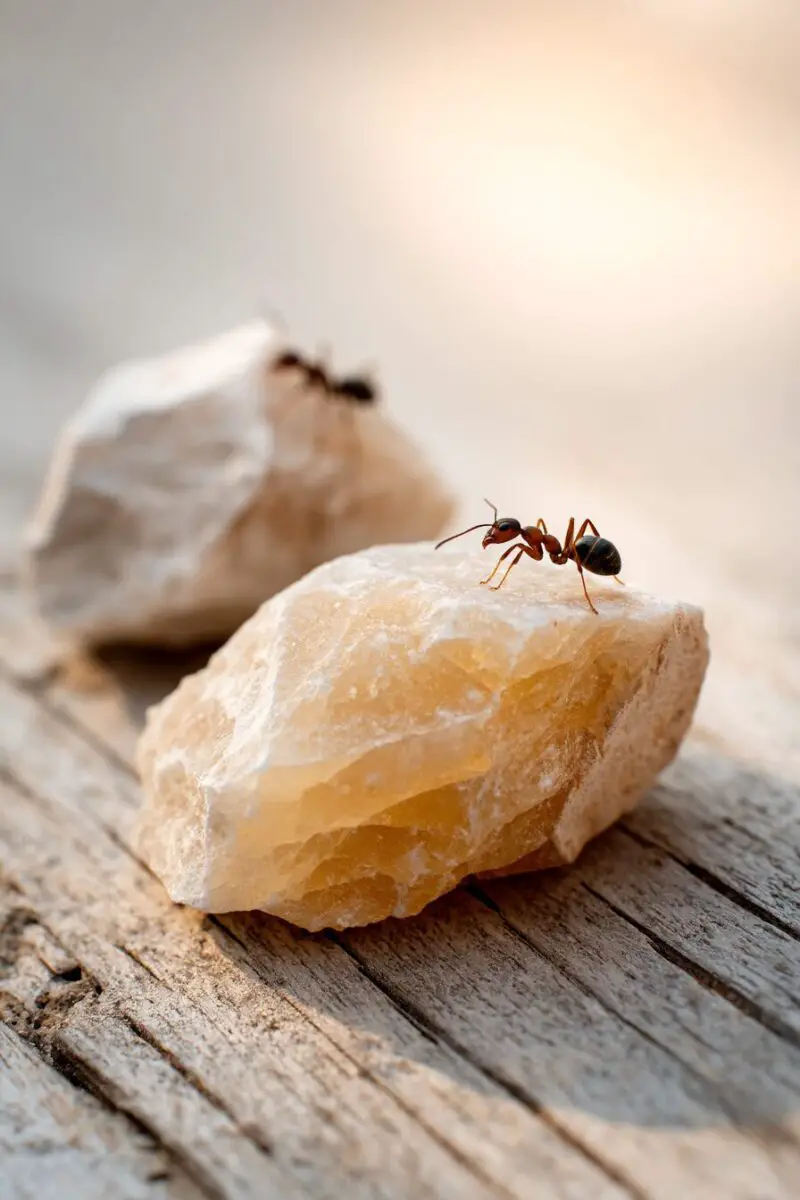
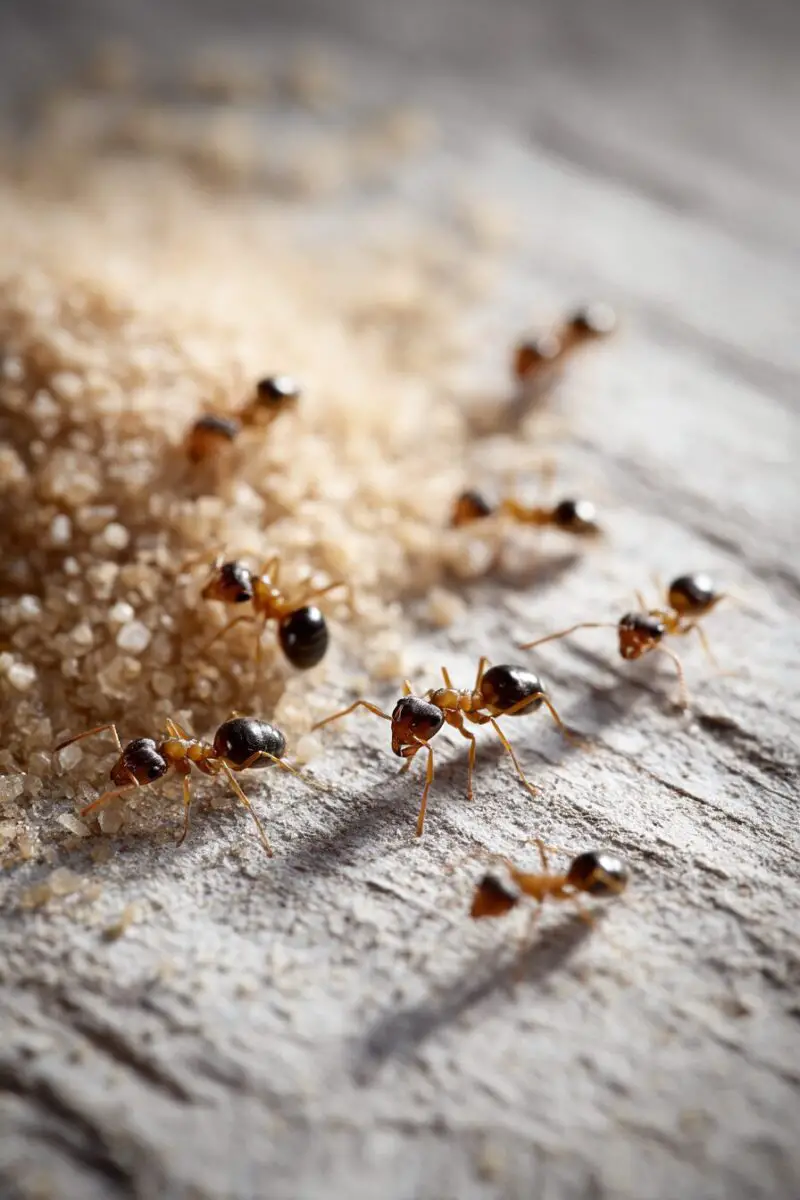
When natural methods aren’t quite cutting it, commercial ant baits offer a powerful solution that targets the heart of your ant problem – the colony itself.
These products are specifically designed to attract ants, who then carry the poisoned bait back to their nest, effectively eliminating the entire colony, including the queen.
Understanding the different types of commercial baits is crucial for success – some contain sweet attractants for sugar-loving ants, while others use protein-based lures for grease-eating species.
Before selecting a bait, take time to observe which foods your particular ants are attracted to – if they go after your donuts, choose a sweet bait; if they raid your pet’s food bowl, opt for a protein-based product.
Most commercial ant baits use either borax compounds or insect growth regulators (IGRs), both of which work slowly enough to allow worker ants to return to the colony before dying.
Bait stations provide a safe, enclosed delivery system that keeps the poison away from children and pets while remaining accessible to ants.
Placement is critical – position bait stations directly on ant trails, near entry points, and in areas with high ant activity for maximum effectiveness.
Patience becomes essential when using commercial baits, as complete elimination may take one to two weeks while the poison circulates throughout the colony.
Resist the urge to kill ants you see around the bait stations – these workers are actually doing the work of carrying poison back to destroy the colony.
For severe infestations, consider using multiple bait stations of the same type rather than mixing different poisons, which can sometimes counteract each other.
Modern ant baits are designed to be highly attractive to ants while containing minimal amounts of active ingredients, making them safer than the broadcast pesticides of the past.
Gel baits offer precise application in cracks, crevices, and hard-to-reach areas where traditional bait stations might not fit.
Outdoor bait stakes can create a protective perimeter around your home, intercepting ants before they make their way indoors.
Always read and follow the manufacturer’s instructions carefully – improper use can reduce effectiveness and potentially create unnecessary exposure to chemicals.
The seasonal timing of bait application matters – many professional exterminators recommend applying baits in early spring before ant populations explode during warmer months.
If you have pets or children, look for bait stations with tamper-resistant features that prevent accidental exposure to the bait inside.
For large outdoor ant mounds, specialized granular baits can be sprinkled around the nest entrance, where foraging ants will collect and distribute them throughout the colony.
Liquid baits often work faster than solid formulations because they’re immediately consumable and can be shared quickly among colony members.
The key advantage of commercial baits over sprays is their colony-eliminating potential – while sprays might kill dozens of visible ants, baits can destroy thousands hidden in nests, addressing the root of your infestation.
Outdoor Barrier Treatments to Stop Ants Before They Enter

Creating a defensive perimeter around your home might be the most proactive approach to ant control, stopping these persistent pests before they ever set foot indoors.
Barrier treatments typically involve applying a liquid or granular pesticide around your home’s foundation, creating an invisible boundary that ants cannot cross.
Professional-grade barrier products often provide residual protection lasting several months, making them a low-maintenance solution for ongoing ant prevention.
For a natural approach, diatomaceous earth can be sprinkled in a band around your home’s perimeter, creating a physical barrier that dehydrates ants as they attempt to cross.
Granular repellents containing essential oils like cedarwood, peppermint, or citronella offer an effective and pleasant-smelling alternative to traditional chemical barriers.
The timing of barrier application matters – early spring deployment, before ant activity peaks, provides the best preventative protection throughout the warmer months.
Rain can wash away many barrier treatments, so consider using products specifically labeled as “waterproof” or “rain-resistant” for longer-lasting protection.
Creating a gravel or rock border around your foundation not only looks attractive but also provides a natural barrier that many ants find difficult to navigate.
If you’re concerned about chemical use, beneficial nematodes – microscopic organisms that feed on ant larvae – can be applied to soil around your home as a biological control method.
Maintaining a dry zone around your foundation by directing downspouts away from the house and trimming back moisture-holding vegetation creates an environment less hospitable to many ant species.
For homes with serious ant problems, consider combining multiple barrier methods – perhaps a chemical barrier at the foundation edge with a natural granular repellent in garden areas closer to the house.
Cinnamon powder sprinkled in a line creates a barrier that most ants refuse to cross, making it an excellent option for doorways and windowsills.
When applying any barrier treatment, pay special attention to areas where utilities enter your home, as these penetrations often serve as superhighways for invading ants.
Mulch, while beneficial for plants, can harbor ant colonies, so consider leaving a mulch-free zone immediately adjacent to your foundation.
Cayenne pepper creates an effective, temporary barrier that can be useful for quick protection during outdoor gatherings or in emergency ant situations.
For long-term protection, some homeowners install copper flashing at the base of their foundation, as many ant species avoid crawling over copper surfaces.
Borax mixed with sugar water can be applied along exterior perimeters to create a barrier that not only deters ants but may eliminate those that attempt to cross it.
Remember that different ant species respond differently to barriers – fire ants might tunnel under them, while carpenter ants might find aerial pathways via tree branches touching your roof.
The width of your barrier matters – most experts recommend a treatment band at least 12-24 inches wide around the entire perimeter of your home.
Combining outdoor barrier treatments with indoor preventative measures creates a comprehensive ant defense system that addresses both existing invaders and prevents future incursions.
Clean and Declutter: Eliminating Ant Attractions
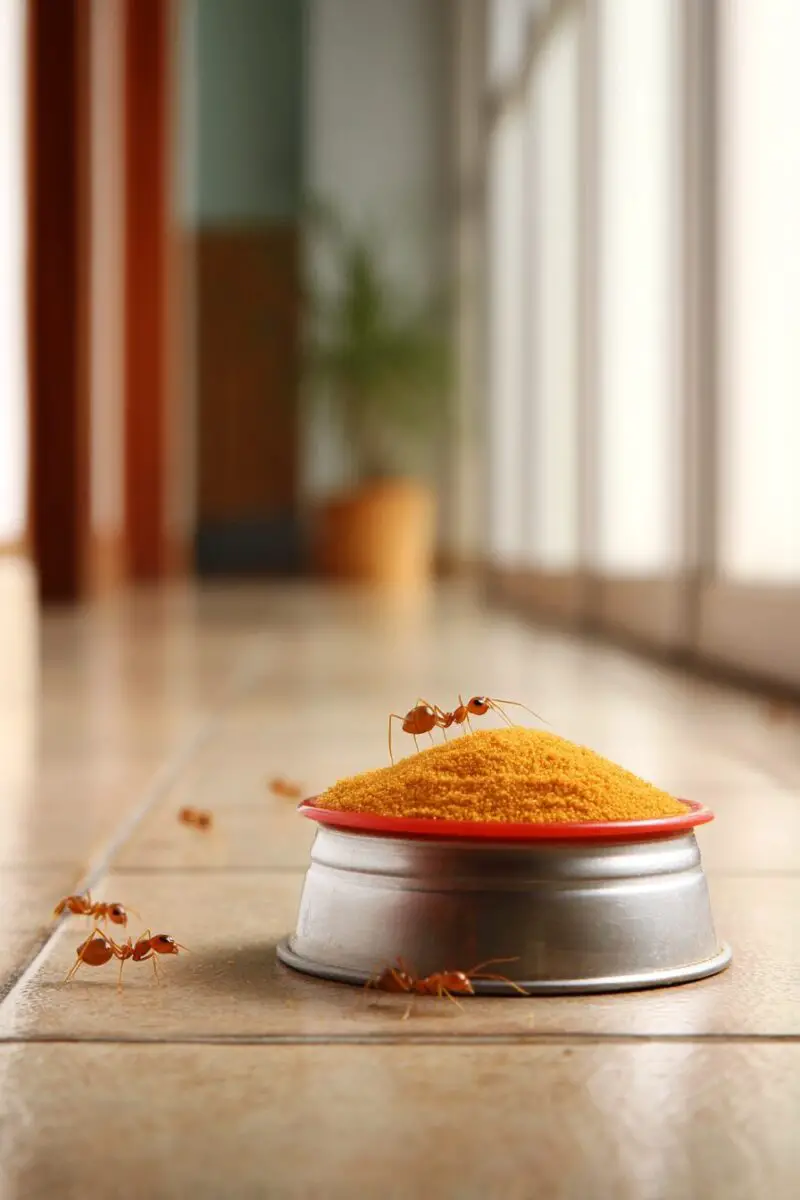

The truth might sting a little, but ants aren’t randomly selecting your home for invasion – they’re following the scent of food, water, and shelter that you’re inadvertently providing.
Implementing a rigorous cleaning routine that eliminates food residue becomes your first line of defense against ant invasions.
Wiping down countertops, tables, and other surfaces with vinegar-based cleaners not only removes food particles but also disrupts the pheromone trails ants use to navigate.
Sweeping and mopping floors daily, especially in the kitchen and dining areas, eliminates crumbs and sticky spots that serve as ant buffets.
The simple habit of washing dishes immediately after meals rather than leaving them in the sink overnight can dramatically reduce your home’s appeal to hungry ants.
Storing food in airtight containers prevents ants from detecting and accessing your pantry provisions.
Pet food bowls often serve as major ant attractants, so consider creating moats around pet dishes or feeding pets at specific times and removing uneaten food promptly.
Regularly emptying and cleaning trash cans, particularly those containing food waste, eliminates a prime ant target in many homes.
Fixing leaky faucets and pipes is crucial, as even small water sources can attract ants, especially during dry weather when they’re desperately seeking moisture.
Decluttering your home reduces potential ant hiding spots and makes it easier to spot and address infestations before they become established.
Cardboard boxes are particularly attractive to some ant species, so consider replacing storage boxes with plastic containers that seal tightly.
Regularly rotating food items in your pantry and refrigerator prevents forgotten items from becoming ant magnets at the back of shelves.
Outdoor maintenance matters too – keeping plants trimmed away from your home’s exterior prevents ants from using branches as bridges to enter.
Firewood should be stored at least 20 feet from your home, as woodpiles frequently harbor ant colonies that can easily migrate indoors.
Removing leaf litter and organic debris from your home’s perimeter eliminates potential nesting sites for various ant species.
Regularly cleaning under and behind major appliances addresses hidden food spills that often become ant hotspots.
The space between your stove and countertop is particularly notorious for collecting food debris, making it a prime target for your cleaning efforts.
Sealing leftovers properly before refrigerating them prevents food odors from attracting ants to your kitchen.
For homes with children, establishing “food zones” where eating is permitted helps contain potential ant-attracting crumbs to specific, easily cleaned areas.
Addressing moisture issues in bathrooms, laundry rooms, and basements eliminates water sources that attract certain ant species, particularly carpenter ants that are drawn to damp wood.
Professional Pest Control: When to Call in the Experts
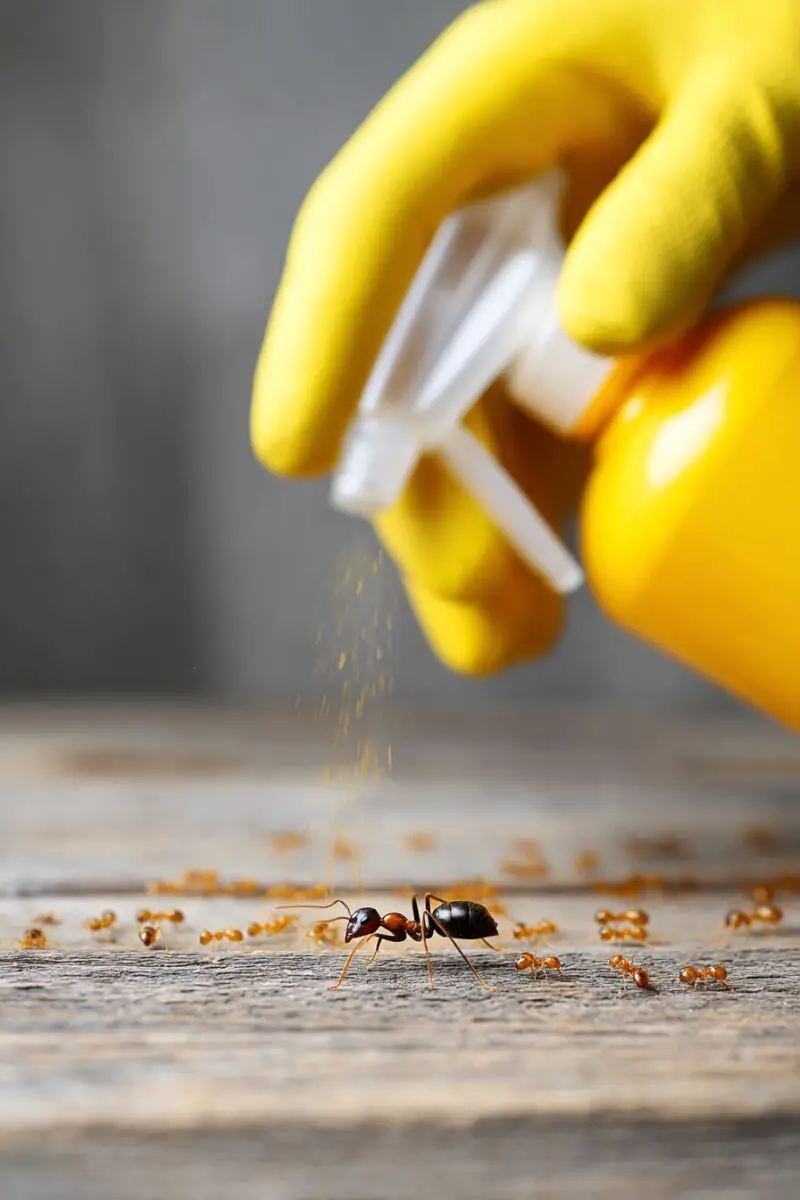
Sometimes, despite your best DIY efforts, an ant infestation can become too established or complex for home remedies alone, signaling it’s time to call in professional reinforcements.
Professional pest control technicians bring specialized training, commercial-grade products, and equipment that allow them to address severe or persistent ant problems more effectively than most homeowners can.
Certain ant species, like carpenter ants that damage wood or pharaoh ants that can carry pathogens, warrant immediate professional intervention due to the risks they pose.
If you’ve tried multiple control methods without success, professionals can identify why your efforts haven’t worked and develop a targeted approach based on the specific ant species invading your home.
Professional treatments typically provide longer-lasting results, often keeping ants at bay for months rather than the weeks or days common with DIY solutions.
Experienced exterminators can locate and treat ant colonies directly, addressing the source of your problem rather than just the symptoms you’re seeing inside your home.
Most reputable pest control companies now offer eco-friendly and low-toxicity options that are safer for homes with children, pets, or residents with health concerns.
The cost of professional service often proves worthwhile when compared to the ongoing expense of repeatedly purchasing DIY products that provide only temporary relief.
Many pest control companies offer service guarantees, returning at no additional charge if ants reappear within a specified time frame after treatment.
For multi-unit buildings like apartments or condominiums, coordinated professional treatment may be necessary, as ants can simply move between units if only one residence is treated.
Professional exterminators can identify structural issues or moisture problems that might be attracting ants, helping you address these underlying conditions.
Regular professional service creates a protective barrier around your home that deters not just ants but often other common pests as well.
Technicians can access difficult areas like wall voids, crawl spaces, and attics where ant colonies might be nesting beyond the reach of typical DIY treatments.
The expertise of professionals becomes particularly valuable when dealing with challenging situations like ant infestations in electronic equipment, medical facilities, or food preparation areas.
If you’re preparing to sell your home, professional pest control documentation can provide peace of mind to potential buyers concerned about previous infestations.
Most pest control companies now emphasize Integrated Pest Management (IPM) approaches that combine chemical treatments with environmental modifications and preventative measures for comprehensive, sustainable control.
For severe outdoor infestations, professionals have access to specialized equipment for treating large areas or multiple ant mounds efficiently.
The time saved by hiring professionals – particularly for busy households – often justifies the cost of service compared to the hours spent on DIY trial and error.
Modern professional ant control typically involves targeted applications rather than widespread spraying, focusing treatments precisely where needed while minimizing chemical use elsewhere.
Perhaps most importantly, professionals bring peace of mind, allowing you to stop worrying about ants and get back to enjoying your home without unwelcome six-legged visitors.
Armed with these powerful strategies, you’re now equipped to tackle even the most stubborn ant invasions.
Remember that combining multiple methods often yields the best results, and persistence is key when dealing with these resilient insects.
Here’s to reclaiming your home from those tiny invaders!

